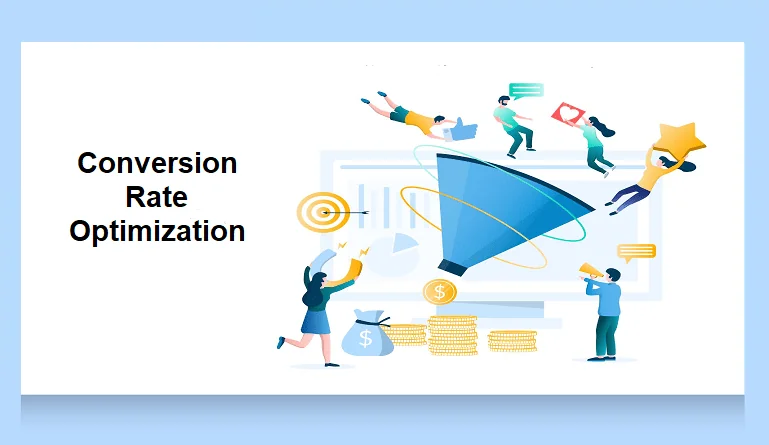Conversion Rate Optimization (CRO) is a key strategy in digital marketing that focuses on increasing the percentage of website visitors who complete desired actions. These actions include purchasing, signing up for a newsletter, or downloading a resource. CRO is about maximizing your existing website traffic, not just increasing it.
Here are key insights, proven strategies, and practical tools to harness the full potential of CRO. Implementing these methods will equip you to enhance your online performance and drive meaningful business results.
Conversion Rate Optimization relies on several key concepts that form its foundation. These concepts help marketers understand how to measure success and implement effective strategies.
What is Conversion Rate?
Conversion rate is the percentage of visitors who complete a desired action on your website. This metric is crucial for understanding how well your site is performing in terms of achieving your business goals.
To calculate the conversion rate:
- Identify your goal (what constitutes a conversion).
- Track the number of conversions.
- Divide conversions by total visitors, then multiply by 100.
For example, if your site had 10,000 visitors and 500 completed purchases, your conversion rate would be 5%.
-
Types of Conversions
Different businesses have various conversion goals. Understanding what constitutes a conversion for your business is essential for effective CRO.
Common types of conversions include:
- Product purchases (e-commerce): A visitor buys a product from your online store.
- Newsletter sign-ups (lead generation): A user provides their email address for updates.
- Free trial activations (SaaS companies): A potential customer signs up for a trial of your software.
- Resource downloads (content marketing): A visitor downloads a whitepaper or e-book.
-
The Conversion Funnel
The conversion funnel represents users’ path from their first interaction with your site to the final conversion. Understanding this journey helps identify potential drop-off points and opportunities for optimization.
A typical conversion funnel includes:
- Awareness stage: Users become aware of your brand or product.
- Interest stage: Visitors express interest by exploring your site.
- Consideration stage: Potential customers evaluate your offer.
- Decision stage: Users decide whether to convert or not.
-
A/B Testing Basics
A/B testing compares two versions of a webpage or element to determine which performs better. This approach allows you to make data-driven decisions about website changes.
The process involves:
- Creating two versions (A and B) of a page or element.
- Randomly showing these versions to different visitors.
- Analyzing which version leads to more conversions.
- Implementing the winning version.
The Importance of CRO for Business Growth
Conversion Rate Optimization (CRO) is a pivotal strategy for business growth. Unlike traditional methods focusing solely on increasing traffic, CRO refines your existing digital assets to maximize their impact.
-
Amplifying Website Performance
CRO transforms your website into a high-performance conversion machine. Fine-tuning elements like layout, content, and functionality create a frictionless path from visitor to customer. This targeted approach often yields better results than broad-stroke marketing efforts.
-
Data-Driven Decision Making
At its core, CRO is about harnessing the power of data. It provides invaluable insights into user behavior, allowing businesses to make informed decisions that directly impact their bottom line. This analytical approach guarantees that every change is purposeful and results-oriented.
-
Cultivating Customer Loyalty
Beyond initial conversions, CRO plays a crucial role in fostering long-term relationships. A well-optimized site not only converts but delights users, encouraging repeat visits and word-of-mouth referrals. This ripple effect can significantly boost customer lifetime value.
-
Data-Driven Results
Recent statistics highlight the significant impact of CRO:
- Personalized messaging results in 72% more engagement.
- Stikky, a software-as-a-service company, increased conversions by 15% after implementing Shopify’s checkout sheet kit.
These numbers highlight CRO’s potential to drive substantial business performance and ROI improvements.
Key Engagement Metrics to Monitor in CRO
Tracking key engagement metrics is crucial for optimizing conversion rates. These metrics provide valuable insights into user behavior and help identify areas for improvement. Some essential metrics to monitor include bounce rate, which measures visitors leaving after viewing only one page, and session duration, which tracks the average time users spend on your site.
Pages per session indicate the average number of pages viewed during each visit, while click-through rate (CTR) shows the percentage of users clicking on a specific link. Exit rate measures the percentage of visitors leaving a particular page, and conversion rate by channel helps evaluate the performance of different traffic sources.
-
Developing an Effective CRO Strategy
To create a successful CRO framework, follow these steps:
- Goal Setting
Establish clear, actionable objectives using the SMART criteria (Specific, Measurable, Achievable, Relevant, Time-bound). This approach ensures your efforts are focused, and progress can be measured effectively.
- Performance Analysis
Use analytics tools to gain a comprehensive understanding of your current site performance. This analysis helps identify areas for improvement and establishes a baseline for measuring future success.
- Comparative Testing
Implement A/B testing to compare different versions of your site elements. This data-driven approach lets you decide which variations resonate best with your audience and drive higher conversions.
- User Experience Optimization
Enhance the user journey to boost conversion rates. Focus on improving navigation, increasing page load speed, ensuring mobile responsiveness, and simplifying form completion processes.
- Content Personalization
Tailor your content to individual users to significantly increase conversion rates. Develop targeted messaging for different user segments and use dynamic content to provide relevant, engaging experiences.
- Ongoing Improvement
Remember that CRO is a continuous process. When you want to refine and enhance your strategies consistently, review your metrics regularly, gather user feedback, and stay informed about new optimization techniques.
Advanced Strategies for CRO
Consider implementing advanced strategies to improve your CRO efforts. These techniques can help you fine-tune your approach and achieve even better results.
-
Leveraging Psychological Principles
Understanding human psychology can help you create more persuasive and effective marketing strategies. Incorporating psychological triggers can influence user behavior and increase the likelihood of conversions.
Some fundamental psychological principles to consider:
- Scarcity: Highlight limited-time offers or low stock levels to create a sense of urgency
- Social Proof: Display customer reviews, testimonials, or usage statistics to build trust
- Reciprocity: Offer free valuable content to encourage reciprocal action from users
-
Implementing Automation Tools and Chatbots
Technology can play a significant role in enhancing the user experience and streamlining the conversion process. Automation tools and chatbots can provide personalized assistance and timely information to your visitors.
Consider implementing these technologies:
- Automated email sequences: Send personalized follow-ups based on user actions
- Live chat support: Provide instant assistance to visitors with questions
- AI-powered recommendations: Suggest products or content based on user behavior
-
Optimizing Conversion Paths
The journey from initial interest to final conversion should be as smooth and intuitive as possible. Optimizing your conversion paths can reduce friction and increase the likelihood of users completing desired actions.
Key strategies for optimizing conversion paths:
- Reduce steps: Minimize the number of clicks required to complete a conversion
- Provide clear guidance: Use visual cues and directional copy to guide users
- Address objections: Anticipate and answer potential concerns throughout the process
The Role of Effective CTAs in CRO
Compelling Calls-to-Action (CTAs) are crucial for conversions. Consider both design and copy when creating CTAs:
- Use action verbs: “Start Your Free Trial Now” instead of “Free Trial.”
- Create urgency: “Limited Time Offer: Save 50% Today” vs “Save 50%”
- Make visually distinct: Use contrasting colors and white space
- Keep concise: 2-5 words, e.g., “Get Your Free E-book”
- Tailor to user stage:
- New visitors: “Learn More”
- Returning visitors: “See Pricing Plans”
- Cart abandoners: “Complete Your Purchase”
These CTAs are clear and action-oriented, encouraging users to proceed in the conversion process.
Utilizing Split Testing to Improve CRO
A/B testing, or split testing, is a fundamental Conversion Rate Optimization (CRO) technique. This method enables data-driven decision-making by comparing two versions of a webpage or specific element. You can continuously enhance your website’s performance and boost conversion rates by systematically evaluating different variations.
-
Implementing Effective A/B Tests
It’s crucial to follow a structured approach to conduct successful tests:
- Select a Target Element: Identify the specific component you want to optimize.
- Develop Variants: Create the original version (A) and an alternative (B).
- Distribute Traffic: Utilize A/B testing tools to present these versions to visitors randomly.
- Gather Sufficient Data: Allow the test to run for a statistically meaningful duration.
- Evaluate Outcomes: Analyze the results to determine which version performs better.
- Apply Findings and Iterate: Implement the winning variant and plan your next test.
-
Maximizing A/B Testing Effectiveness
Make sure your split tests yield accurate and actionable insights by doing the following:
- Focus on isolating variables by testing one element at a time.
- Tests should be conducted for at least two weeks to account for temporal fluctuations.
- Ensure your site receives adequate traffic to achieve statistically significant results.
Common CRO Mistakes to Avoid
Even experienced marketers can fall into certain traps when implementing Conversion Rate Optimization strategies. Being aware of these common mistakes can help you avoid pitfalls and improve the effectiveness of your CRO efforts.
-
Inadequate Testing
Basing decisions on assumptions rather than evidence often leads to costly mistakes. Validate their true effectiveness by implementing rigorous testing for all ideas, regardless of how certain you are of their success.
-
Mobile Optimization Oversight
Ignoring mobile users is a critical error. Cater to this dominant user base by ensuring your site is fully responsive and conducting thorough mobile-specific testing.
-
Misaligned Metrics
Don’t focus on vanity metrics like raw traffic numbers. Instead, focus on indicators directly impacting your bottom line, such as conversion rates and revenue per visitor, to drive meaningful business growth.
-
Poor Site Performance
Slow-loading pages can severely hamper user experience and conversions. Regularly audit and optimize your site’s speed across all devices to maintain a competitive edge and maximize user engagement.
Measuring the Impact of CRO on ROI
If you want to understand the value of your Conversion Rate Optimization efforts truly, you need to measure their impact on your Return on Investment. Key performance indicators (KPIs) that reflect the influence of CRO on ROI include:
-
Conversion Rate:
The percentage of visitors completing a desired action. Boost this through enhanced user experience and site optimization to improve ROI.
-
Cost Per Acquisition (CPA):
The expense of acquiring a new customer. Effective CROs should reduce this while maintaining customer quality.
-
Customer Lifetime Value (CLV):
Total expected revenue from a customer. Increase CLV by improving user experience and fostering loyalty.
-
Revenue Per Visitor (RPV):
Average revenue generated per visitor. Improve through optimized user journeys and targeted offerings.
Tools and Technologies for Effective CRO
Having the right tools can make a significant difference. These technologies can help you gather data, analyze user behavior, and implement changes more efficiently.
-
Heatmap and Behavior Analysis
- Mouseflow: Visualizes user interactions with scroll maps and click heatmaps
- Contentsquare: Offers AI-driven insights and zone-based heatmaps
-
Session Recording
- Smartlook: Provides event-based recordings and automatic event tracking
- LogRocket: Combines session replay with error tracking and performance monitoring
-
A/B Testing
- Convert: Offers Bayesian-powered testing and personalization features
- Kameleoon: Provides AI-driven A/B testing and full-stack experimentation
-
Analytics
- Amplitude: Focuses on product analytics and user behavior tracking
- Heap: Offers automatic event tracking and retroactive analytics
-
All-in-One Platforms
- Plerdy: Combines heatmaps, session recording, and conversion funnels
- Decibel: Provides digital experience analytics with a focus on user frustration detection
Case Studies of Successful CRO Implementations
Examining real-world examples of successful conversion rate optimization (CRO) strategies provides valuable insights into your efforts. Let’s look at three companies that have effectively implemented CRO to improve their ROI.
-
DashThis
DashThis, a digital marketing reporting tool, faced challenges in converting free trial users to paid customers. They focused on:
- Redesigning the layout with bolder buttons
- Simplifying the setup process
- Adding tutorial guides
Results:
- 50% increase in free trial users converting to paid customers
- 140% improvement in customer satisfaction
This case highlights the importance of user experience in the conversion process.
-
Hubstaff
Hubstaff, a time-tracking software, overhauled its homepage to improve conversions. Their approach included:
- Conducting heatmap analysis
- Reorganizing copy and visuals
- Implementing a split URL test
Their efforts led to a 49% increase in visitor-to-trial conversion rate, demonstrating the power of data-driven decision-making in CRO.
-
World of Wonder
World of Wonder, facing time constraints, used AI optimization tools to:
- Evaluate visitor behavior
- Dynamically personalize content
- Automate A/B testing
Results:
- 7% overall increase in conversion lift
- DragCon UK event leads conversion rate increased from 12.7% to 31.9%
- The streaming service conversion rate grew to 29.7%
This case showcases how AI tools can support CRO efforts, especially for teams with limited resources.
( Also Read: Conversion Optimization Strategy Benefits B2B Companies )
Building a CRO-Friendly Website Design
Website design plays a crucial role in Conversion Rate Optimization (CRO). A practical layout guides users toward desired actions, while a harmonious color scheme evokes appropriate emotions. Intuitive navigation reduces friction, encouraging users to explore and convert.
Enhance engagement and conversions by prioritizing clear calls-to-action, using white space effectively, guaranteeing mobile responsiveness, and implementing persuasive visual elements like trust badges and customer testimonials.
The Impact of Page Load Speed on CRO
Page load speed significantly influences conversion rates. Slow-loading pages frustrate users, leading to higher bounce rates and abandoned conversions. Even a one-second delay can result in substantial revenue loss.
When optimizing load speed, you must compress images, leverage browser caching, minify CSS and JavaScript, use a content delivery network (CDN), and prioritize above-the-fold content loading. Regular performance audits will also help identify and address speed bottlenecks.
Future Trends in Conversion Rate Optimization
As technology evolves, so does CRO. Here are some emerging trends to watch:
-
AI-driven personalization:
Using machine learning to deliver highly personalized experiences.
-
Voice search optimization:
Adapting CRO strategies for voice-activated devices.
-
Mobile-first strategies:
Prioritizing mobile experiences in all CRO efforts.
-
Privacy-focused optimization:
Adapting to stricter data privacy regulations.
-
Micro-conversions:
Focusing on smaller user actions that lead to primary conversions.
-
Emotional analytics:
Using AI to gauge and respond to users’ emotional states.
-
Augmented Reality (AR) in e-commerce:
Enhancing product visualization and user engagement.
-
Progressive Web Apps (PWAs):
Improving user experience across devices and connection speeds.
Final Thoughts
Conversion Rate Optimization is a powerful strategy for improving ROI in digital marketing. When enhancing user experience, leveraging data-driven insights, and continuously testing and refining your approach, you can significantly increase the effectiveness of your online presence.
Take note that CRO is an ongoing process. Stay committed to analyzing your metrics, testing new ideas, and adapting to changing user behaviors. When you continue to stay persistent and use a systematic approach, you’ll be well on your way to achieving higher conversion rates and a more substantial ROI for your digital marketing efforts.
Frequently Asked Questions about Conversion Rate Optimization
Q. What’s the difference between CRO and SEO?
A. SEO focuses on increasing website traffic, while CRO aims to convert that traffic into meaningful actions.
Q. Can CRO negatively impact my website’s performance?
A. CRO can slow down your website or create user experience issues if not done correctly.









